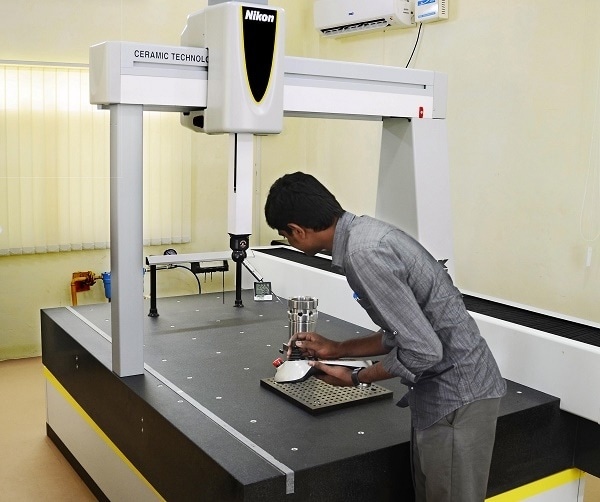 A Fine Forge CMM operator setting up inspection of a turbine blade using the Nikon Metrology LC15Dx laser scanner.
A Fine Forge CMM operator setting up inspection of a turbine blade using the Nikon Metrology LC15Dx laser scanner.
Industry leader in the forging of steel turbine blades in India, Fine Forge, has installed a multi-sensor Nikon Metrology coordinate measuring machine (CMM) at its Hyderabad facility.
The tactile probing and laser scanning acquisition system, used for quality assurance (QA) and reverse engineering, has helped to increase productivity and support the expansion of the company’s product portfolio.
Operating primarily in the power generation sector, the ISO 9001:2000 certified company was established in 1989 to reduce the need to import stainless steel blades for steam turbines and replace them with locally manufactured components, in response to a push by the Indian authorities.
Since that time, the firm has diversified into other industries, such as supplying steel forgings to the automotive sector.
Multi-sensor CMM combines high accuracy and throughput
Occupying a large percentage of Fine Forge’s production, the turbine blades are made from X20, X10 and X22 stainless steels. The company manufactures up to 95 types of moving blade and 24 types of guide blade, all of which have different, complex geometries.
A system that could simplify 3D scanning of the wide range of varying shapes and sizes was required.
Fine Forge previously used manual and destructive measurement, for which data collection methods were particularly time-consuming. The company wanted to replace its manual methods and was keen to avoid the waste of expensive materials and parts.
It was also looking to introduce reverse engineering capabilities to help slash computer-aided design turnaround times.
Several potential CMM suppliers were asked to offer a fast, accurate, multi-sensor system that could facilitate both QA and reverse engineering. Nikon Metrology proposed the fullest and most comprehensive solution.
Increased productivity, better insight and new possibilities
The multi-sensor ALTERA CMM with CAMIO software combines touch probing, SP25 continuous scanning and laser scanning, providing Fine Forge with a complete inspection toolbox.
In terms of accuracy, the Nikon LC15Dx laser head is closing the gap with tactile inspection systems, delivering the most accurate results possible for a laser scanner.
Thanks to the optical chain design using a Nikon focusing lens, the scanner is able to achieve a probing error of just 1.9 µm. Not only does it facilitate the measurement of complex shapes, but it generates results with speed and precision, giving Fine Forge an impressive tool for all inspection and reverse engineering requirements.
The SP25 is an ideal partner for the laser scanning probe. For difficult-to-access areas such as internal features and diameters, or if there are only a few sections to measure, the tactile SP25 is very functional.
In CAMIO, changing between the laser scanner and tactile probes is completed with just a few clicks of a mouse.
After the arrival of the Nikon system, the team at Fine Forge expressed its satisfaction with the investment and the opportunities introduced. The increase in blade productivity since the installation has helped the company to look for other business opportunities and expand into different sectors, which has been advantageous as power industry work has now peaked.
Managing director Vinod Reddy explained that the company is now exploring new possibilities in the supply of pipe fittings and heavy truck components and described the laser scanner as a “phenomenal advantage”.
He added that many pipe fitting manufacturers do not have drawings of their parts, but the introduction of the LC15Dx with its reverse engineering capabilities made entering this market possible.
However, turbine blade manufacture remains a core part of the business. The introduction laser scanning has enabled measurement of larger, complex sheet metal blades, which was not previously possible. It has therefore extended the manufacturer’s expertise and scope as well as improving its analysis and reporting procedures.